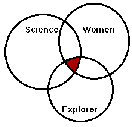|
|
More on Prospecting1. Scanning the Information LandscapeWhat's out there? Before we start "drilling" for oil, actually opening up and reading articles, we would be wise to survey the offerings and get a general feeling for the landscape of a particular topic. When we turn to the Internet, we have three basic sources which support this kind of scanning: |

|
Scanning entails looking over the first 50 "hits" to see the patterns - staying on the surface without "drilling."
Scanning delivers two opportunities:
Finding the Good:
Scanning develops a profile of the landscape so you have some sense of where to "drill" - which sites might be worth visiting and which ones to avoid. You skim the brief abstracts, asking all the while, "How much relevance is this likely to have?"
Screening the Irrelevant:
It provides a basis to modify your original search strategy to eliminate or screen out irrelevant materials.
Once your simple inquiry turns up so many irrelevant sites, you can select the Advanced Query option from the top of the AltaVista page and eliminate various words which are indicators of irrelevant items as I did with the following:
Explorers NEAR (science or scientific) AND NOT ("Science Explorers" OR child OR children OR museum OR club OR cruise OR school OR young OR New OR NASA OR summer OR enrichment OR project)
It is essential that schools teach both staff and students to employ the advanced searching features of these engines as a natural part of prospecting.
2. Identifying the Key Factors for Convergence
The Prospector's Primer from Chevron (http://www.chevroncars.com/know/primer/) mentioned above explains the importance of convergence:
The goal is to find a convergence of the geologic elements necessary to form an oil or gas field. These elements include (1) a source rock to generate hydrocarbons, (2) a porous reservoir rock to hold them and (3) a structural trap to prevent fluids and gas from leaking away. Traps tend to exist in predictable places - for example, along faults and folds caused by movement of the Earth's crust or near subsurface salt domes.
When it comes to information-seeking, the convergence is established by creating a logical intersection of search words and key concepts, the combination of which are most likely to identify relevant sites and articles.
In the example given above for "science explorers," the first strategy to reduce the mountain of irrelevant information was to use the "AND NOT" search function (called a "logical operator") to eliminate records containing certain words likely to indicate irrelevancy.
Achieving convergence requires thought regarding key word choice and placement (proximity). By combining just the right words in just the right order - which may take some trial and error - the information searcher can focus upon the confluence (like the meeting of two rivers) of the information streams.
In Boolean Logic, this UNION is represented by the intersection of two or more circles . . .

Careful word choice is a logical "closing in upon" the target, a centering, tapering focalization upon the most important and pertinent information.
A main character in William Gibson's recent novel, IDORU, has the job of "an intuitive fisher of patterns of information," actually trying to help a TV program expose the sins of celebrities by looking for trends in vast databases of seemingly innocent information like credit card charges, phone calls and household bills.
Laney was the equivalent of a dowser, a cybernetic water-witch. (pg. 25)
He'd spent his time skimming vast floes of undifferentiated data, looking for "nodal points" he'd been trained to recognize . . ." (pg. 25)
. . . info-faults that might be followed down to some other kind of truth, another mode of knowing, deep within gray shoals of information.(pg. 39)
We are after the same nodes as Gibson's cyber-witch . . . the junctions, meeting-points, intersections, and crossroads which enable us to "make up our minds," "put 2 and 2 together," and make sense from non-sense.
Whether we think in terms of nodes or convergence, we are looking for the connections which allow us to strike oil or gold.
3. Being Alert to Clues
Scanning hundreds of "hits" we are intuitively seeking words and elements in the brief abstracts which serve as an intimation or tip-off of something to go by. We hope for a tell-tale sign, a hint, a straw in the wind, an OMEN, perhaps.
In seeking scientific explorers, the word "biography" popped up as an important clue early in my first searching.
Credits: Credits: The prospector image is a cartoon from Charles Miles, owner of Grin Graphics Company, whose work appears on Barry's Clip Art Server and is available for non-commercial use. Several of the icons are from Barry's Clip Art Server. The Other drawings, photographs and graphics are by Jamie McKenzie. © 2006, Jamie McKenzie, all rights reserved.
Copyright Policy: These pages may not be duplicated, distributed, redistributed or republished in any manner without express permission.